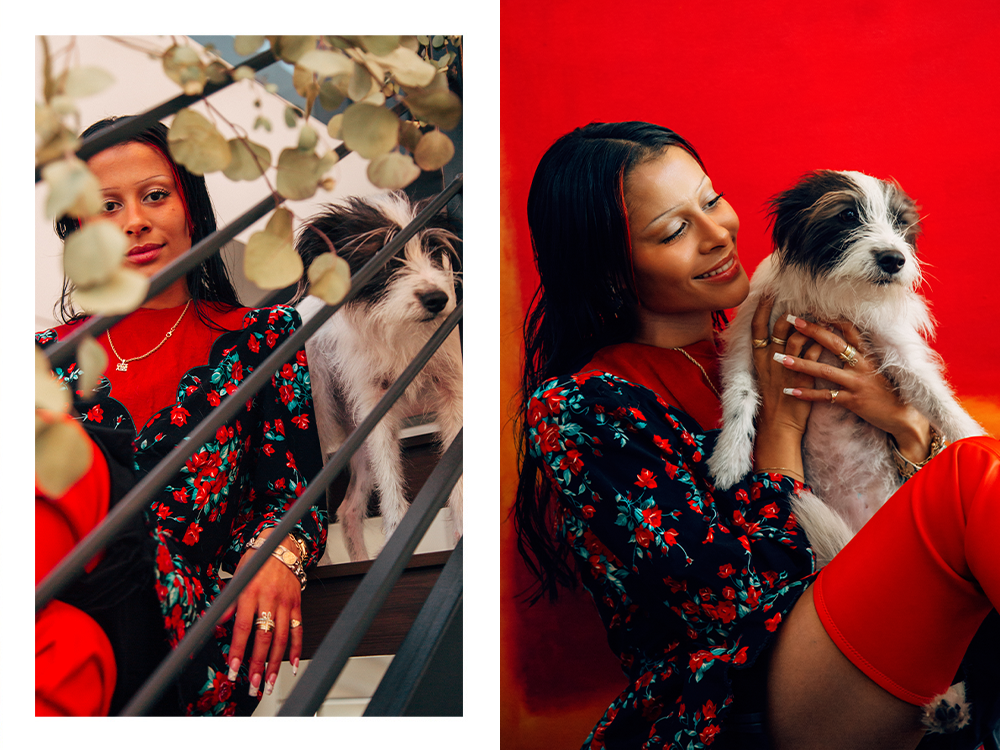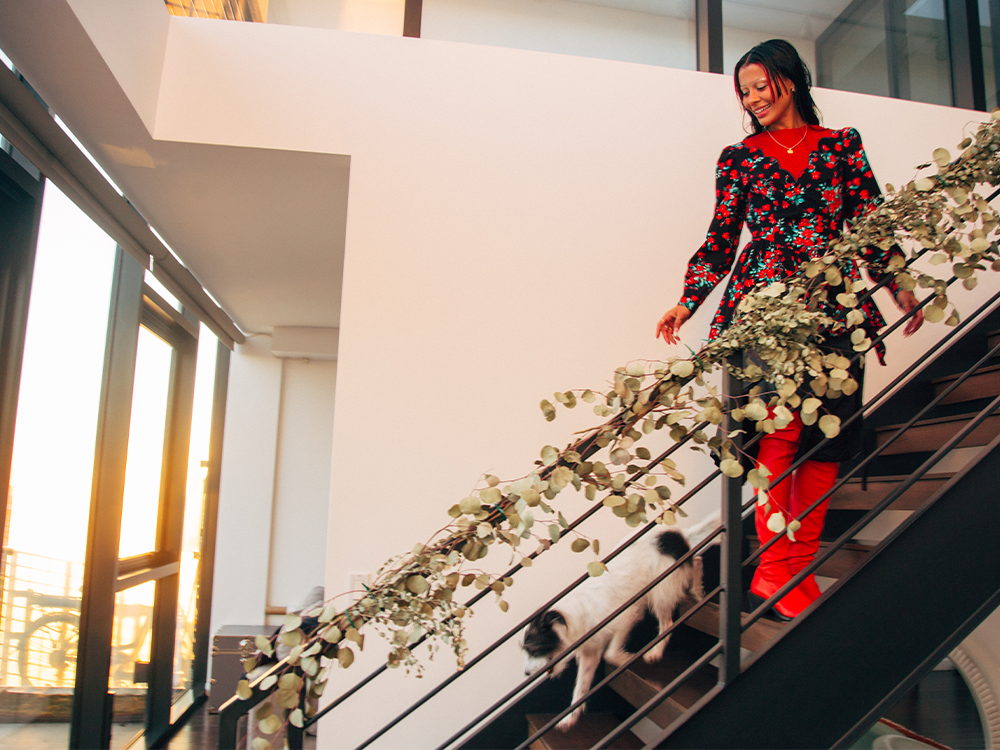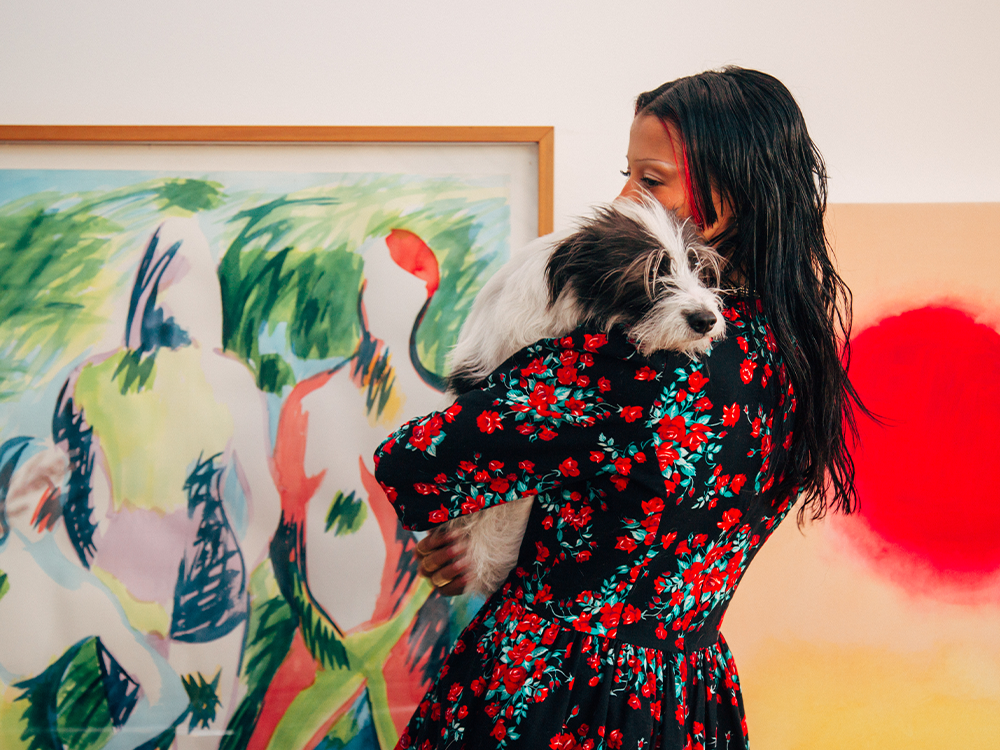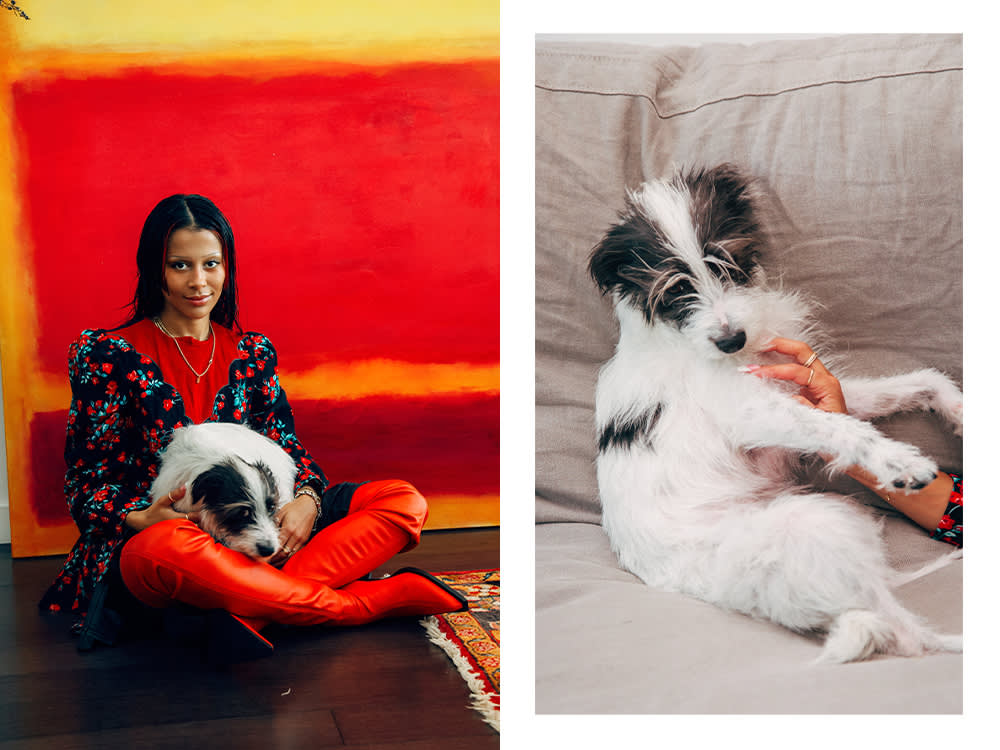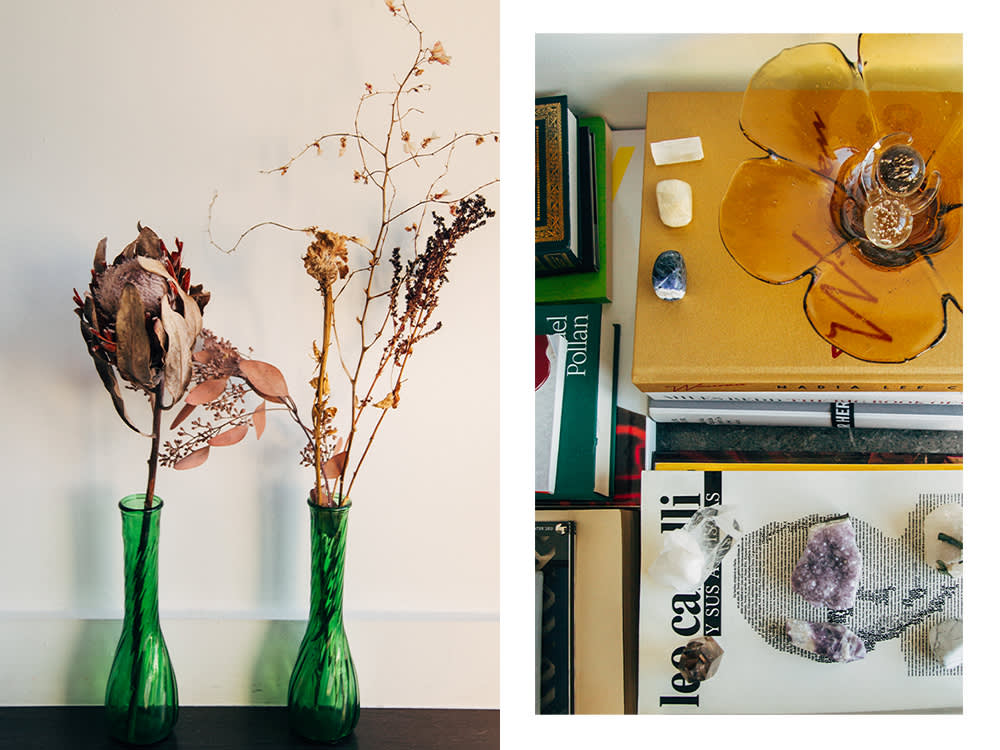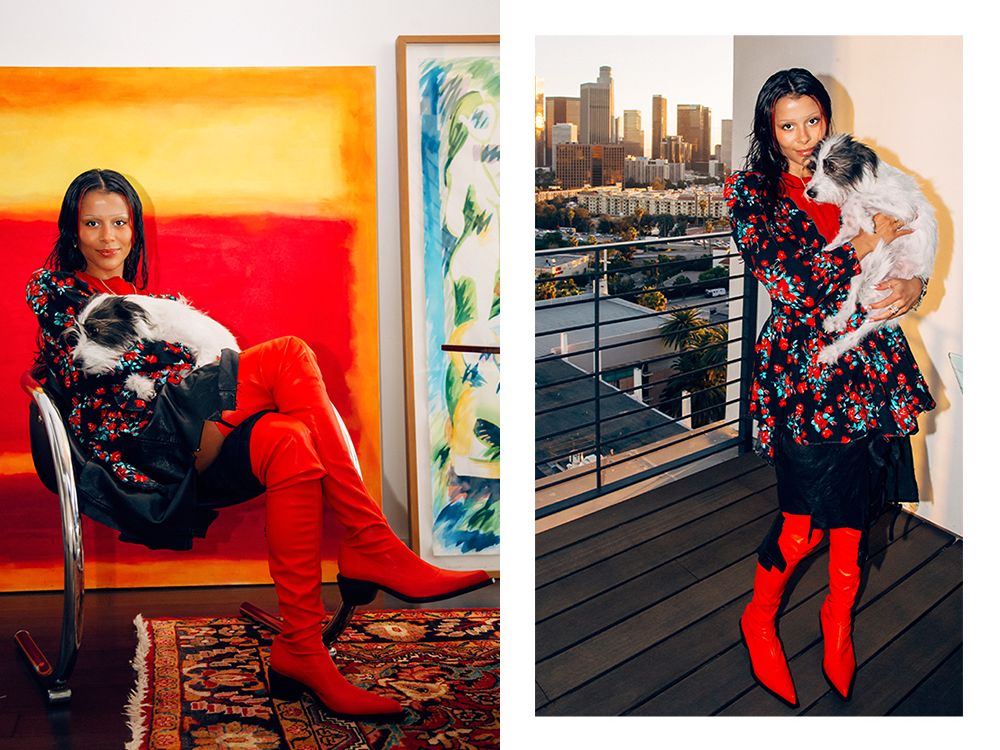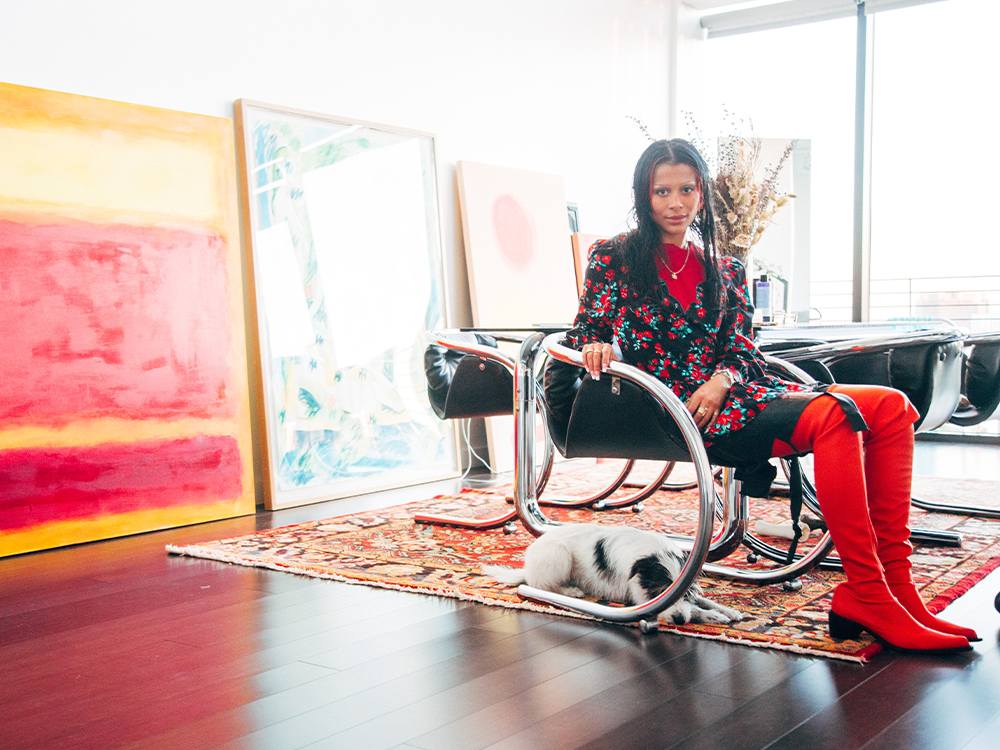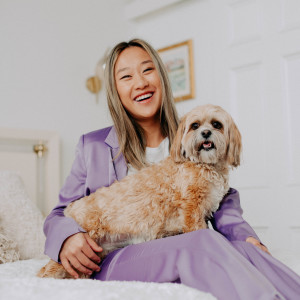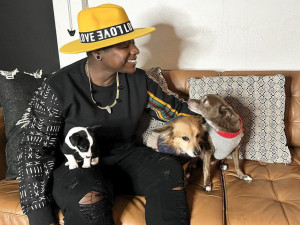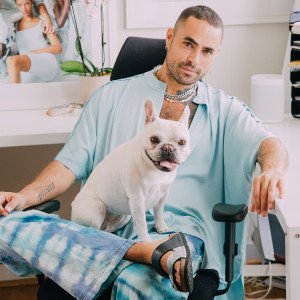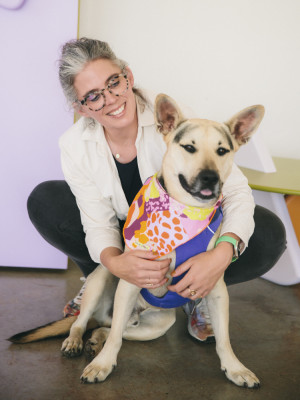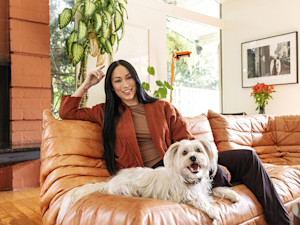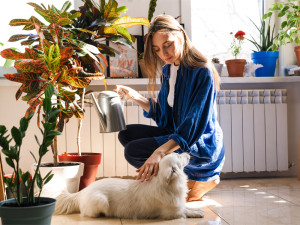Sami Miró’s “Super-Mutt” Sunnie Helps Her Find Her Center
Especially when the eco-forward fashion designer has red carpet nerves.
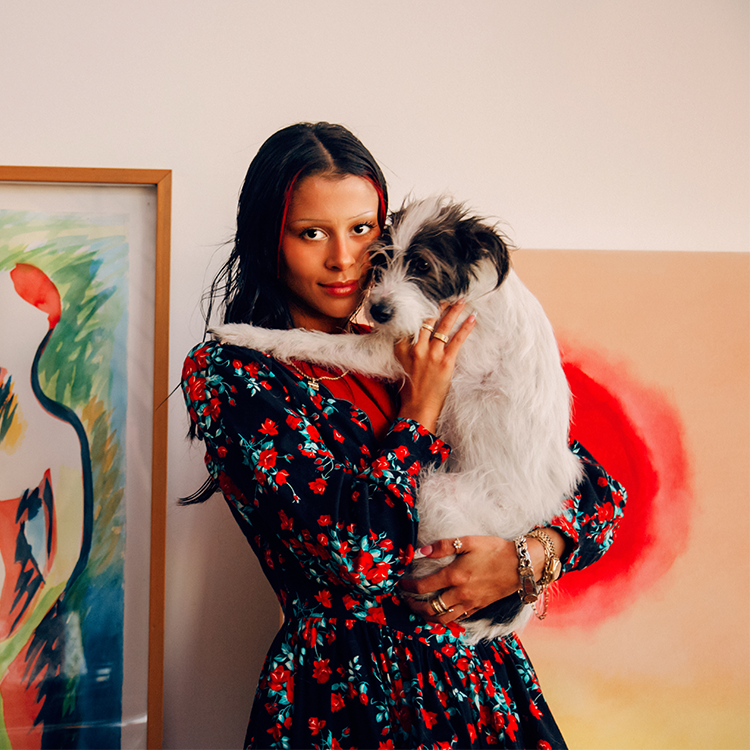
share article
Selena Gomez, Rosalía, Teyana Taylor, Kylie Jenner, Bella Hadid, Dua Lipa…look around, and you’ll be hard-pressed to find a fashion-forward celeb who hasn’t been photographed wearing Sami Miró Vintageopens in a new tab (a.k.a. SMV). Still, the woman behind the eponymous brand has even bigger endeavors: merging style with substance to encourage people to dress more sustainably.
The stats behind Miró’s mission: Fashion is responsibleopens in a new tab for roughly 10 percent of global industrial carbon-dioxide emissions (that’s more than airplanes and shipping combined). It’s guiltyopens in a new tab of producing a fifth of the world’s plastic. Meanwhile, 70 percentopens in a new tab of clothing we buy ends up in landfills.
The designer also recognizes that other brands claim to be eco-focused but don’t necessarily walk the walk. “Greenwashing is a marketing ploy; [brands] are portraying themselves as being sustainable when they’re really not,” she told opens in a new tab last year. “A lot of labels are now trying to be a part of this trend and get sales from it, so they might be doing one small thing, but it’s not making much of a difference.” (Miró’, who told The Wildest that her early fashion inspiration was “big old man clothes or boy clothes,” told W that her fashion icon is her dad.)
Miró’s remarkable ascent in the fashion world happened after she received a Master’s in Global Entrepreneurship and working at a tech start-up for four years. In a 2016 interview with opens in a new tab, following the launch of SMV, she admitted that her path wasn’t exactly traditional — but allowed her to feel more stable.
“I feel like I kind of did it backwards,” she said. “I like that I have something solid to fall back on. I mean, everybody wants to do fashion or music or acting, you know?”
Regardless of how she got there, Miró’s success can be attributed to her BIPOC roots growing up in San Francisco and her indefatigable work ethic, as well as Sunnieopens in a new tab, her canine companion. A rescue pup, Sunnie, is an adorable mix of Pit Bull Terrier, Chihuahua, German Shepherd, Basset Hound, Miniature Poodle, and about five more breeds. “I like to call her a super-mutt,” Miró tells the Wildest. She adds, adoringly, that Sunnie “has textbook Disney dog eyes.”
In January, we spoke with the warm, thoughtful Miró — fresh from an appearanceopens in a new tab at the Golden Globes — about all of the above, and asked her for a few tips on becoming a more eco-conscious opens in a new tabpet parent.
How did Sunnie come into your life?
I had been wanting a dog for so many years. And I just wasn’t at a place in my life where I could prioritize that. It’s a big responsibility! So, in 2020, it was a possibility for me. I was on a hunt for months. Ideally, I wanted a dog that was under 30 pounds to make traveling easy. [A rescue] sent me this photo of baby Sunnie. It was just the saddest and most darling photo I had ever seen. She was at the vet and looked so afraid. Her legs were, like, sticking out straight, and she looked all disgruntled and funny. I had no idea how big she was going to be. But I said, “This is my dog.” Everything kind of flew out the window when I saw her.
You did name her Sunnie, so I’m guessing she is a very happy dog.
I had a very long list of name options. And it was between “Perry” and “Sunnie.” Yes, she does happen to be the sweetest, happiest dog. She loves all dogs. She loves all humans. Her tail is wagging probably 90 percent of the time that she’s awake.
What’s also cool is that your dog, like you, is multiracial!
When I was younger, I went to a pretty much all-white high school. For, like, two out of the four years, I was the only Black person in the entire school. And so the very ignorant, rich white kids would call me a mutt and say mean shit like that to me. So I wanted my dog to be, like, the most super-mutt of all dogs!
I’d love to hear about how Sunnie creatively inspires you.
That’s an interesting question that I’ve never thought of, actually. She goes with me everywhere. She absolutely loves being at the office. She helps with stress opens in a new taband anxiety tremendously. The other day, I was stressed because I was working on a gown [for myself] for the Golden Globes. And I had a moment where I almost had a panic attack. Then I saw her. I was like, “Oh, my gosh, I gotta get my mind right because I have Sunnie here.” In those moments, she definitely helps me because I always want to be there for her and take care of her.
Speaking of creativity, you have a very enlightened approach to fashion. How did you decide that sustainability and eco-friendly style would drive what you did in life?
Growing up in San Francisco, being eco-conscious is just the way of living, whether it’s recycling and composting or thinking about chemicals you’re putting in or on your body. When I started out, it was really just a passion project to combine my business acumen from school with my new realization of design and fashion. I cannot be a part of something that I truly don’t believe in, even if I become a billionaire overnight.
It means so much to me to hear people say I inspired them or that they haven’t seen anybody who looks like them doing something in entrepreneurship or in fashion or in sustainability. That just means everything to me because I didn’t get that growing up.
How did you learn to make clothes?
I was raised by my dad and have an older brother. So, all my hand-me-downs were big old man clothes or boy clothes. They were all, like, massive on me, so I would cut them, pin them, and rework them since I was — I don’t know — like 12 or 10 or something like that.
Now you’re dressing all these celebrities! Who was the first one who really believed in you?
That’s an easy answer: Selena Gomez. My good friend was her assistant. I had just started SMV maybe two months or less before. I remember the first samples I gave [Selena] were the only pieces in existence. After that, she was like, “OK, I want you to redesign my global tour?” — which I did. But that’s kind of the story of my career. I have a bachelor’s in marketing and a master’s in global entrepreneurship and management. And none of it has to do with fashion. The whole thing has just been the life of an autodidact. I’ve had to teach myself how to do everything. So, I really love new experiences because it just makes you grow so much faster.
As a BIPOC woman and designer, how has Sunnie supported you?
You know, when Black people started incorporating dogsopens in a new tab in their lives…it wasn’t stemming from, you know, the love of a dog and having this animal as part of the family. It was for protection, and that stems into something so much larger, which is overall mental health in our communities. It wasn’t about mental health for me until a year ago. I had a lot of childhood trauma. And I realized about six months ago that I’ve had severe anxiety.
I remember my first anxiety attack: I was three years old, and I remember it vividly. Since I’ve had Sunnie, for a little over two and a half years, I’ve been realizing these things about mental health in general. It’s an innate thing within dogs. Any time somebody is crying or sniffling — like even the most subtle thing — she’ll recognize if somebody is upset and jump on you and cuddle you.
Would you ever make doggie clothing?
I would absolutely love to make doggie clothing! Everybody knows that Sunnie is such an important part of my life. However, I still need to build out my human clothing side of the business first before I can move on. But it’s definitely on my radar. I think that doing some sort of collaboration would be so fun. Some of my best sellers are a v-cut hoodie and my safety-pin sweatpants. I could do a jumpsuit version of that for dogs. Or little puffer jackets. I mean, it’s, like, endless. I have so many designs.
Does Sunnie like being dressed up?
She actually likes wearing clothes. She doesn’t try and bite them off. She’ll be in a sweater all day. Last year for Halloween, I got her little bat wings. And she was feeling, like, evil-cute. She has a lot of sweaters and jackets and stuff. She has a really cute raincoat. She’s very stylish when it is winter and needs to be warm.
Since you’re so entrenched in the world of sustainability, do you have any tips for pet parents? How can we do better?
Just, you know, really changing your buying habits. It’s so easy to get a pack of dog toys from Amazon that are made from really bad chemicals. I would encourage people to rethink the types of things that they’re buying, and which types of toys are going to have a longer lifespan. Food is a really big one, too. I feed Sunnie a few different types of food. She’s not a kibble girl. She has, you know, real food in the natural shape of food. You can actually see what’s inside of it.
The way that things are packaged is also really important: going more towards the larger packages that use less plastic or some brands that are super, super [eco-friendly], [with] materials and packaging [that are] more conscious. In general, whether it’s for you or your animal or your child or your friend — whatever it is, just think through a purchase, “How long am I going to have this? How is it made?” Be aware of the decision that you’re making.

Nisha Gopalan
Nisha Gopalan has been a writer/editor for The New York Times, New York magazine, Entertainment Weekly, Variety, The Hollywood Reporter, and NYLON magazines. She currently resides in Los Angeles.
Related articles
![]() opens in a new tab
opens in a new tabAnnie Wu Henry’s Pup Is a Skilled Senate Campaign Member
Sen. John Fetterman’s “TikTok whisperer” works hard, but Bella helps her chill.
![Stoney Michelli Love with her two dogs]() opens in a new tab
opens in a new tabStuzo Founder Stoney Michelli Love Is “Coming for the Crown” With a New Dog Fashion Line
Fashion without the constraints of gender? Paws up for that!
![A man in light blue loose clothes with his white Pug dog sitting in his lap]() opens in a new tab
opens in a new tabScott Studenberg’s Dog Demands He Have a Healthy Work-Life Balance
The Baja East creative director might call the shots at work, but at home, Donatella is The Boss.
![A cheerful woman with a puppy next to her wearing a vibrant harness.]() opens in a new tab
opens in a new tabAlex Proba’s Dog Knows How to Show Off For the Camera
The abstract artist on how her rescue pup, Sam, photobombed a video project and inspired a brand-new line of dog products.
![Stephanie Shepherd sitting with her dog on a couch]() opens in a new tab
opens in a new tabThe Climate Crisis Needs Better PR. Stephanie Shepherd & Binx Are On It
The Future Earth founder on rescuing a pandemic puppy and using social media to save the planet:
“Our approach is that we’re all in this together during a really transitional, transformational time in society.”![eco-friendly pet parent pets down inside of indoor garden]() opens in a new tab
opens in a new tabHow to Be an Eco-Friendly Pet Parent
Reducing your paw print can seem daunting. Consider these simple tips.
